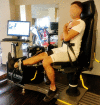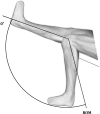Peak torque angle of anterior cruciate ligament-reconstructed knee flexor muscles in patients with semitendinosus and gracilis autograft is shifted towards extension regardless of the postoperative duration of supervised physiotherapy
- PMID: 30721251
- PMCID: PMC6363225
- DOI: 10.1371/journal.pone.0211825
Peak torque angle of anterior cruciate ligament-reconstructed knee flexor muscles in patients with semitendinosus and gracilis autograft is shifted towards extension regardless of the postoperative duration of supervised physiotherapy
Abstract
Background: The observational cohort study investigated whether the flexor muscles peak torque (PT) angle shifting towards extension observed in the involved knee in patients after anterior cruciate ligament reconstruction (ACLR) using semitendinosus and gracilis tendon (STGR) autograft is associated with the postoperative physiotherapy supervision duration.
Methods: From 230 ACL-reconstructed males, we identified patients after ACLR utilizing STGR autograft and divided them into those who completed supervised physiotherapy <6 months (Group I; n = 77) and those who completed supervised physiotherapy ≥6 months (Group II; n = 66). The mean follow-up time was 6.84 ± 1.47 months. The ACL-reconstructed patients were compared to 98 controls (Group III). Bilateral knee flexor muscle PT measurements were performed. The relative PT at 180°/s (RPT), PT angle at 180°/s, and range of motion at 180°/s were analysed. The RPT limb symmetry index (LSI) was calculated. Tests for dependent samples, one-way analysis of variance, post hoc test, and linear Pearson's correlation coefficient (r) calculations were performed.
Results: The shift towards extension was noted when comparing the ACL-reconstructed limb to the uninvolved limb (Group I, p ≤ 0.001; Group II, p ≤ 0.001) and to Group III (p ≤ 0.001), but it was not correlated with physiotherapy supervision duration (r = -0.037, p = 0.662). In ACL-reconstructed patients, there was a moderate association of supervision duration and knee flexor LSI (r = 0.587, p < 0.001).
Conclusions: The ACL-reconstructed knee flexors PT angle shift towards extension was observed regardless of the duration of postoperative physiotherapy supervision. However, the analysis revealed that the duration of supervised physiotherapy positively influenced the RPT and LSI in patients after the ACLR.
Conflict of interest statement
The authors have declared that no competing interests exist.
Figures













Similar articles
-
Are the knee extensor and flexor muscles isokinetic parameters affected by the duration of postoperative physiotherapy supervision in patients eight months after ACL reconstruction with the use of semitendinosus and gracilis tendons autograft?Acta Bioeng Biomech. 2018;20(4):89-100. Acta Bioeng Biomech. 2018. PMID: 30520446 Clinical Trial.
-
Quadriceps tendon autograft ACL reconstructed subjects overshoot target knee extension angle during active proprioception testing.Knee Surg Sports Traumatol Arthrosc. 2020 Feb;28(2):645-652. doi: 10.1007/s00167-019-05795-7. Epub 2019 Nov 27. Knee Surg Sports Traumatol Arthrosc. 2020. PMID: 31776624
-
Effect of physiotherapy on the strength of tibial internal rotator muscles in males after anterior cruciate ligament reconstruction (ACLR).Med Sci Monit. 2011 Sep;17(9):CR523-31. doi: 10.12659/msm.881940. Med Sci Monit. 2011. PMID: 21873950 Free PMC article. Clinical Trial.
-
Passive anterior tibia translation in anterior cruciate ligament-injured, anterior cruciate ligament-reconstructed and healthy knees: a systematic review.Musculoskelet Surg. 2019 Aug;103(2):121-130. doi: 10.1007/s12306-018-0572-6. Epub 2018 Oct 16. Musculoskelet Surg. 2019. PMID: 30328030 Free PMC article.
-
Strength, rate of force development, power and reactive strength in adult male athletic populations post anterior cruciate ligament reconstruction - A systematic review and meta-analysis.Phys Ther Sport. 2021 Jan;47:91-104. doi: 10.1016/j.ptsp.2020.11.024. Epub 2020 Nov 10. Phys Ther Sport. 2021. PMID: 33232907
Cited by
-
Ebbing Strength, Fading Power: Unveiling the Impact of Persistent Fatigue on Muscle Performance in COVID-19 Survivors.Sensors (Basel). 2024 Feb 15;24(4):1250. doi: 10.3390/s24041250. Sensors (Basel). 2024. PMID: 38400407 Free PMC article.
-
Comparative Evaluation of Treatment Outcomes of Revision Anterior Cruciate Ligament Reconstruction Using Allograft and Semitendinosus Autograft.J Clin Med. 2024 Dec 29;14(1):133. doi: 10.3390/jcm14010133. J Clin Med. 2024. PMID: 39797216 Free PMC article.
-
Restoring Knee Flexor Strength Symmetry Requires 2 Years After ACL Reconstruction, But Does It Matter for Second ACL Injuries? A Systematic Review and Meta-analysis.Sports Med Open. 2024 Jan 5;10(1):2. doi: 10.1186/s40798-023-00666-5. Sports Med Open. 2024. PMID: 38180584 Free PMC article.
-
Total Score of Athleticism: Profiling Strength and Power Characteristics in Professional Soccer Players After Anterior Cruciate Ligament Reconstruction to Assess Readiness to Return to Sport.Am J Sports Med. 2023 Oct;51(12):3121-3130. doi: 10.1177/03635465231194778. Epub 2023 Sep 8. Am J Sports Med. 2023. PMID: 37681510 Free PMC article.
-
Prolonged Physiotherapy after Anterior Cruciate Ligament Reconstruction Does Not Improve Muscular Strength and Function.J Clin Med. 2024 Apr 25;13(9):2519. doi: 10.3390/jcm13092519. J Clin Med. 2024. PMID: 38731047 Free PMC article.
References
-
- Segawa H, Omori G, Koga Y, Kameo T, Iida S, Tanaka M. Rotational muscle strength of the limb after anterior cruciate ligament reconstruction using semitendinosus and gracilis tendon. Arthroscopy: the journal of arthroscopic & related surgery: official publication of the Arthroscopy Association of North America and the International Arthroscopy Association. 2002;18(2):177–82. - PubMed
-
- Nakamura N, Horibe S, Sasaki S, Kitaguchi T, Tagami M, Mitsuoka T, et al. Evaluation of active knee flexion and hamstring strength after anterior cruciate ligament reconstruction using hamstring tendons. Arthroscopy: the journal of arthroscopic & related surgery: official publication of the Arthroscopy Association of North America and the International Arthroscopy Association. 2002;18(6):598–602. - PubMed
Publication types
MeSH terms
LinkOut - more resources
Full Text Sources
Medical

